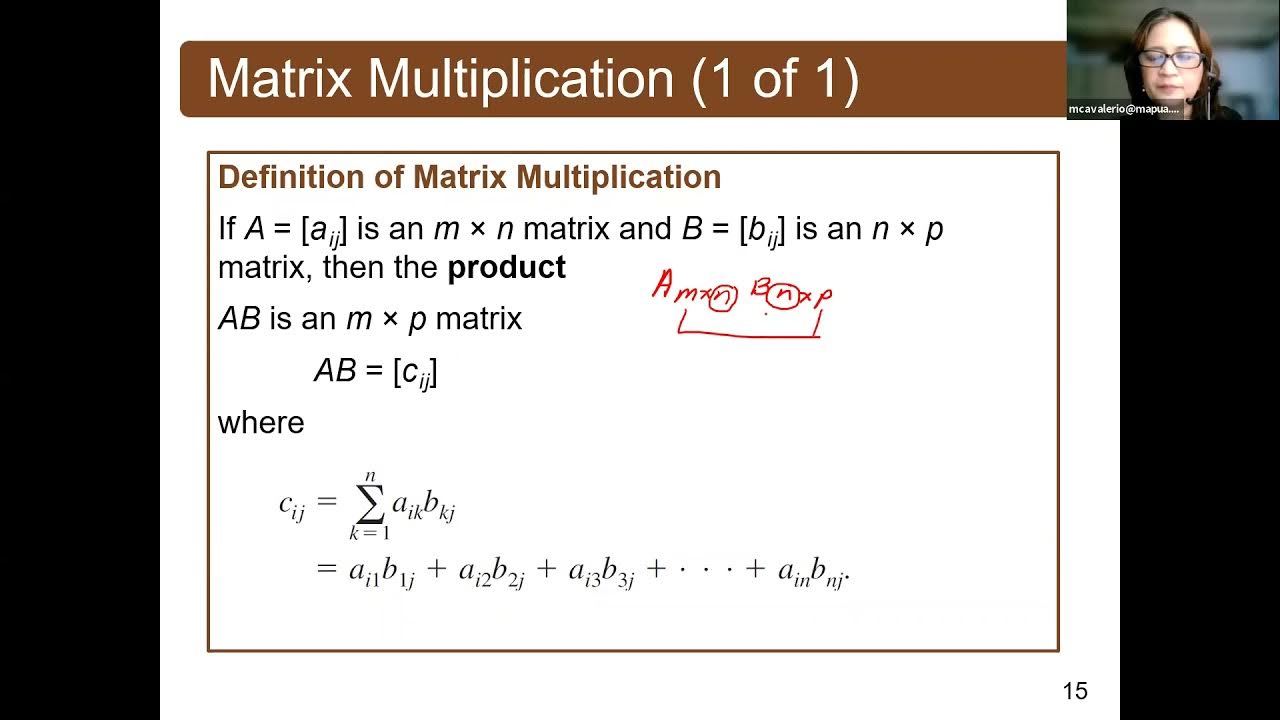Prodotto tra Matrici e Matrice Trasposta
Summary
TLDRThis video explores matrix multiplication and transposition, starting with the fundamentals of multiplying two matrices to produce a new matrix, including step-by-step calculations. It emphasizes the importance of matrix dimensions for valid multiplication and introduces the concept of a transposed matrix, detailing its properties, such as reversing the order of multiplication. Additionally, it covers symmetric matrices, defined as matrices equal to their transposes. The session concludes by previewing upcoming topics, such as inverse matrices and vector spaces, encouraging viewer engagement through likes and social media.
Takeaways
- 😀 Matrix multiplication involves two matrices, where the number of columns in the first must equal the number of rows in the second.
- 😀 The resulting matrix from multiplying an m x n matrix with an n x p matrix is an m x p matrix.
- 😀 Each element of the resulting matrix is calculated by taking the dot product of a row from the first matrix and a column from the second.
- 😀 The formula for finding the element c_{ij} in the resulting matrix C is c_{ij} = Σ (a_{ik} * b_{kj}) for k from 1 to n.
- 😀 To multiply matrices, ensure that the dimensions match; otherwise, the multiplication is not feasible.
- 😀 A matrix's transpose is obtained by swapping its rows with its columns, changing dimensions from m x n to n x m.
- 😀 The transpose of the sum of two matrices equals the sum of their transposes: (A + B)^T = A^T + B^T.
- 😀 The transpose of the product of two matrices reverses their order: (A * B)^T = B^T * A^T.
- 😀 A symmetric matrix remains unchanged when transposed, meaning A = A^T.
- 😀 Matrix multiplication is not commutative; A * B does not equal B * A in general.
Q & A
What is the result of multiplying a matrix of size m x n by a matrix of size n x p?
-The result is a new matrix of size m x p.
How is the element c_{ij} in the resulting matrix calculated?
-The element c_{ij} is calculated as the sum of the products of corresponding elements from the i-th row of the first matrix and the j-th column of the second matrix, expressed as c_{ij} = ∑_{k=1}^{n} a_{ik} * b_{kj}.
What does it mean for matrix multiplication to be non-commutative?
-It means that for two matrices A and B, A × B does not necessarily equal B × A.
What is a transpose of a matrix?
-The transpose of a matrix A, denoted as A^T, is formed by swapping its rows with its columns.
What are the properties of the transpose of a sum and a product of matrices?
-The transpose of a sum of matrices is the sum of their transposes: (A + B)^T = A^T + B^T. The transpose of a product is given by: (A × B)^T = B^T × A^T.
When can two matrices be multiplied together?
-Two matrices can be multiplied if the number of columns in the first matrix equals the number of rows in the second matrix.
What is a symmetric matrix?
-A symmetric matrix is a square matrix that is equal to its transpose, meaning it is symmetric with respect to its main diagonal.
What is the significance of the example given in the video regarding the multiplication of specific matrices?
-The example illustrates how to compute the elements of the resulting matrix by using the defined formula for matrix multiplication, reinforcing the concept through practical application.
What notation is commonly used to denote the transpose of a matrix, and why is it important?
-The transpose is commonly denoted as A^T. It's important because it helps in understanding matrix operations and properties, especially in contexts such as linear algebra and vector spaces.
What future topics will be covered in the next videos as mentioned in the script?
-Future topics include the inverse of a matrix, the rank of a matrix, and an introduction to vector spaces.
Outlines

This section is available to paid users only. Please upgrade to access this part.
Upgrade NowMindmap

This section is available to paid users only. Please upgrade to access this part.
Upgrade NowKeywords

This section is available to paid users only. Please upgrade to access this part.
Upgrade NowHighlights

This section is available to paid users only. Please upgrade to access this part.
Upgrade NowTranscripts

This section is available to paid users only. Please upgrade to access this part.
Upgrade Now5.0 / 5 (0 votes)





